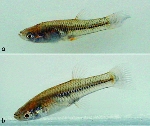NEWS: Section reporting on news on freshwater fishes of Mexico.
News on freshwater fishes of Mexico
By Juan Miguel Artigas Azas (25-Oct-2021)
A new species of killifish in the genus Profundulus has been described in the journal Ichthyology & Herpetology 109(4):949–957 2021 by Sara E Dominguez-Cisneros, Ernesto Velázquez-Velázquez, Caleb D. McMahan, and Wilfredo A. Matamoros. The new species significantly extends the known distribution of Profundulus in the Atlantic slope of Mexico to the upper reaches of the Papaloapan drainage in Oaxaca [México], from which Profundulus until now wasn’t known. The new species has been given the name Profundulus adani, to honor the Mexican ichthyologist Adán E. Gómez González, who tragically passed away in January 2018. P. adani is diagnosed from all congeners by the absence of a humeral spot in individuals larger than 45 mm SL.
Dominguez-Cisneros, Sara E & Ernesto Velázquez-Velázquez, Caleb D. McMahan, Wilfredo A. Matamoros. 2021. "A new species of killifish of the genus Profundulus (Atherinomorpha: Profundulidae) from the upper reaches of the Papaloapan River in the Mexican state of Oaxaca". Ichthyology & Herpetology. 109(4):949–957 (ffm01006) (abstract)

By Juan Miguel Artigas Azas (05-Feb-2020)
A new species of livebearer fish: Poeciliopsis jackschultzi from the state of Sonora in Mexico has been recently described by Kevin Conway, Mariana Mateos and Robert C. Vrijenhoek in the journal Zookeys. The new species is currently only known from four sites in the Río Concepción, where it is sympatric with P. occidentalis. It is mainly diagnosed by the absence of a black spot at base of the frontal part of the dorsal fin on males, unique in the Leptorhaphis species group of Poeciliosis. The specific name is given to honor Jack Schultz, a pioneer of studies on hybridization and all-female reproduction in Poeciliopsis.
Conway, Kevin W & Mariana Mateos, Robert C. Vrijenhoek. 2019. "A new species of the live-bearing fish genus Poeciliopsis from northern Mexico (Cyprinodontiformes, Poeciliidae)". Zookeys. (883):91-118. DOI: 10.3897/zookeys.883.37586 (ffm00905) (abstract)

By Juan Miguel Artigas Azas (09-May-2017)
A new species of Thorichthys has been described in the journal Revista peruana de biología: 24(n. 1), pp. 3-10. The new species, endemic to the Coatzacoalcos river drainage in Mexico, has been known for many years as Cichlasoma (Thorichthys) "helleri" (Artigas Azas 1991, who first recognized the species as new), Thorichthys sp. 'Coatzacoalcos' (Stawikowski et al, 1998) and later as Thorichthys sp. ‘mixteco’ in several publications. This species is diagnosed by the authors from the rest of the Thorichthys species by a set of meristic characters (that actually don’t difference it from them) and by the presence of a “black blotch on the dorsal fin of the females between the sixth and seventh spine” (which actually T. helleri also has in some populations). The specific name chosen for the species, panchovillai, is to honor the Mexican revolution prominent figure José Doroteo Arango Arámbula (Pancho Villa). Why such a beautiful fish was named after a notorious murdered and thief that in a power struggle was partially responsible of the killing of 20% of Mexican population at the beginning of the 20th century, and never put a foot on the land of this beautiful species, is mysterious at least.
del Moral Flores, Luis Fernando & E. López-Segovia, T. Hernández-Arellano. 2017. "Descripción de Thorichthys panchovillai sp. n., una nueva especie de cíclido (Actinopterygii: Cichlidae) de la cuenca del Río Coatzacoalcos, México". Revista peruana de biología. 24(1):3-10 (ffm08118) (abstract)

By Juan Miguel Artigas Azas (30-Nov-2016)
Two new species of Xenotoca closely related to Xenotoca eiseni (Rutter, 1896) have been proposed by Omar Domínguez-Domínguez, Dulce María Bernal-Zuñiga and Kyle Piller in the journal Zoodata. The two new species: X. doadrioi and X. lyonsi honor respectively Ignacio Doadrio from the National Museum of Natural History [Madrid] for his support of numerous studies on Mexican fish, and John Lyons, who has extensively worked on the conservation of fishes of central Mexico, particularly Goodeids. The two new species comprise isolated populations of what was until now known as Xenotoca eiseni, and are split on a diagnosis comprised of a combination of meristic and morphometric characters. Previous mitochondrial DNA comparisons had shown that the three populations are evolving independently from each other. In the current proposal Xenotoca eiseni is restricted to some lowland affluents of the Rio Grande de Santiago near Compostela, Nayarit. X. doadrioi is limited to the population found in ponds and streams in the area around Etzatlan, Jalisco, and finally X. lyonsi is restricted to the population around Tamazula, Jalisco, found in affluents of the Coahuayana River. The three species are now referred as the Xenotoca eiseni group.
Domínguez Domínguez, Omar & D.M Bernal-Zuñiga, K.R. Pyler. 2016. "Two new species of the genus Xenotoca Hubbs and Turner, 1939 (Teleostei, Goodeidae) from central-western Mexico". Zootaxa. 4189(1):81-98. DOI: 10.11646/zootaxa.4189.1.3 (ffm00865) (abstract)